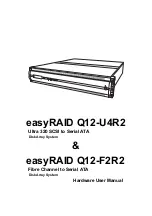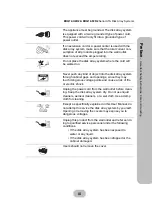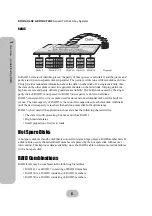
6
ERQ12-U4R2 & ERQ12-F2R2
Serial ATA Disk Array Systems
1
Ove
rview – Un
der
sta
ndi
ng RAID
RAID 5
In RAID 5, data is divided into pieces; the parity of these pieces is calculated; and the pieces and
parity are written to separate disks in parallel. The parity is written to a different disk each time.
Parity provides redundant information about the data on other disks. If a single disk fails, then
the data on the other disks is used to regenerate the data on the failed disk. Striping delivers a
high access rate and parity delivers good data availability. The bottleneck caused by the single
parity disk of RAID 3 is not present in RAID 5, since parity is stored on all disks.
RAID 5 consists of two or more disks used for data and one additional disk used for fault tol-
erence. The total capacity of RAID 5 is the sum of the capacities of each data disk. Add disks
until the desired capacity is reached, then add one more disk for fault tolerance.
RAID 5 is best used with applications whose data has the following characteristics:
• The data is worth protecting, but not as much as RAID 1
• High read data rates
• Small proportion of writes to reads
Hot Spare Disks
A hot spare disk is a standby disk that is not used for data storage unless a RAID member fails. If
a disk failure occurs, the failed RAID member is replaced by the hot spare disk without user
intervention. This improves data availability, since the RAID is able to tolerate more disk failures
with a hot spare disk.
RAID Combinations
RAID levels may be combined in the following hierarchies:
• RAID 0+1 is a RAID 1 consisting of RAID 0 members
• RAID 30 is a RAID 0 consisting of RAID 3 members
• RAID 50 is a RAID 0 consisting of RAID 5 members
















































